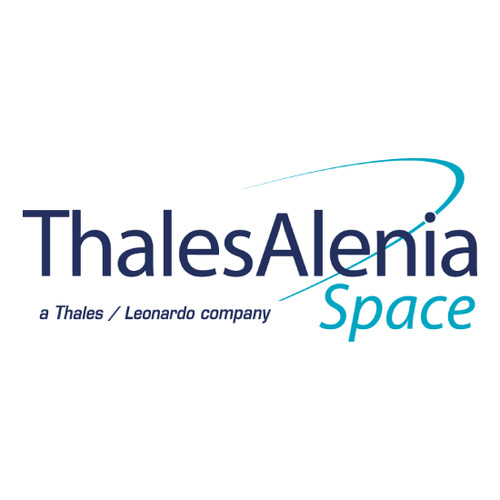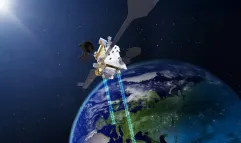Enhanced monitoring of air quality and greenhouse gas concentrations
- MTG-S1 is an integral part of the Meteosat Third Generation (MTG) program, which comprises six satellites: four imaging satellites and two atmospheric sounding satellites.
- MTG-S1’s primary mission is to map Earth’s atmosphere in 3D.
- It will join MTG-I1, the first imaging satellite in the program, successfully launched in 2022.
Cannes, July 2, 2025 – The MTG-S1 meteorological observation satellite was successfully launched from Cape Canaveral, Florida. Built by OHB System AG, MTG-S1 carries Europe’s first hyperspectral infrared sounding instrument designed for geostationary orbit. Thales Alenia Space, the joint company between Thales (67%) and Leonardo (33%), is responsible for the development, assembly, integration and testing of the main payload, which includes a high-precision interferometer and an advanced infrared detection system.

MTG-S1 © ESA
About MTG-S1
The primary objective of the MTG-S1 sounding satellite is to improve Europe’s numerical weather prediction (NWP) capabilities, both at regional and global scales. Thanks to its hyperspectral infrared sounding instrument, MTG-S1 enables 3D mapping of the atmosphere by precisely measuring temperature and humidity across latitude, longitude and altitude. These measurements will enable forecasters to detect the early warning signs of storms and will improve NWP models.
MTG-S1 also carries the Copernicus Sentinel-4 instrument, built by Airbus Defence and Space, which is dedicated to monitoring air quality and greenhouse gas concentrations from space. This instrument is equipped with an ultraviolet, visible and near-infrared spectrometer.
The combination of these two instruments will contribute to improved air quality forecasting and will provide a wealth of information for the benefit of public health, agriculture and scientific research.
About the MTG program
The MTG-S1 satellite is part of the Meteosat Third Generation (MTG) program, developed by Thales Alenia Space as prime contractor for the European Space Agency (ESA) and the European Organization for the Exploitation of Meteorological Satellites (EUMETSAT).
This program will ensure the continuity of European weather monitoring beyond 2040. It is based on a constellation of six satellites: four imaging satellites (MTG-I), built by Thales Alenia Space, and two atmospheric sounding satellites (MTG-S), developed by OHB.
The MTG-I imaging satellites carry latest-generation instruments, including lightning detectors, built by Leonardo, and the FCI imager, which can deliver weather data in near-real time. The first satellite in the series, MTG-I1, was launched in 2022 and returned its first images in 2023, demonstrating a significant improvement over previous generations.
The system provides updated images of Earth every 10 minutes (compared with 15 minutes previously) and delivers images over Europe every 2.5 minutes in rapid scan mode.
“The Meteosat Third Generation constellation will profoundly transform weather forecasting capabilities by providing a more frequent, accurate and comprehensive picture of atmospheric phenomena,” said Bertrand Denis, VP Observation, Science and Exploration for Thales Alenia Space. “Once all six satellites are fully operational in orbit, EUMETSAT will have some of the most advanced forecasting capabilities in the world.”
Half a century of geostationary weather satellites
Thales Alenia Space has been prime contractor for three generations of Meteosat satellites since the launch of the first flight model in 1977. The company built seven first-generation Meteosat satellites, four second-generation satellites, and is leading the development of the six third-generation satellites as prime contractor. It is also involved in the development of the ground segment for EUMETSAT, through the design and delivery of the Image Data Processing Facility. Telespazio, the joint company between Leonardo (67%) and Thales (33%), is also involved in the ground segment, both in data acquisition and satellite command and control. In addition, it will provide EUMETSAT with launch and early orbit phase (LEOP) services for two satellites, with an option for a third.
Since 1977, Meteosat satellites have been the main source of meteorological data for Europe and Africa. The data from these satellites is one of ESA and EUMETSAT’s key contributions to the World Meteorological Organization’s Global Observing System.
About Thales Alenia Space
Drawing on over 40 years of experience and a unique combination of skills, expertise and cultures, Thales Alenia Space delivers cost-effective solutions for telecommunications, navigation, Earth observation, environmental monitoring, exploration, science and orbital infrastructures. Governments and private industry alike count on Thales Alenia Space to design satellite-based systems that provide anytime, anywhere connections and positioning, monitor our planet, enhance management of its resources and explore our Solar System and beyond. Thales Alenia Space sees space as a new horizon, helping build a better, more sustainable life on Earth. A joint venture between Thales (67%) and Leonardo (33%), Thales Alenia Space also teams up with Telespazio to form the Space Alliance, which offers a complete range of solutions including services. Thales Alenia Space posted consolidated revenues of €2.23 billion in 2024 and has more than 8,100 employees in 7 countries with 15 sites in Europe.


